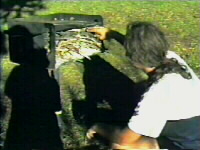In the old days, the sun was really rushing across the sky, in order to be able to go to bed
quickly. A god named Maui was not happy at all with only a few hours of daylight. His mother
was trying constantly to dry her clothes in the sun but the sun set way too soon each day.
So Maui decided to handle the situation his way. He made strong ropes, climbed the Haleakala
mountain during the night and waited patiently for the sun to appear. And when it did, Maui
caught the sun by the rays, using strong ropes. After a heavy struggle, the sun was trapped.
Maui refused to let the sun go until it promised to travel across the sky at lower speed. So,
thanks to Maui, his mother was able to dry her clothes and we all now have longer days.
 That old Hawaiian tale gave name to the Haleakala mountain - the House of the Sun. Haleakala
is the highest point of the island of Maui, the second largest among Hawaiian islands. The
summit rises to 3055 meters above the sea. The views from the top are glorious: to the
northwest, the Molokai and Lanai islands and to the southeast, the Big Island with distant Mauna
Kea and Mauna Loa. On a clear day, even Oahu might be in sight. But one thing that strikes the
visitors the most is the sunrise at the summit of Haleakala. Thousands are getting up before 4am
to be able to get to the top in time to see the sunrise. But the sunset is great, too, as you can
see on the picture. The mountain top is high above the thick layer of clouds.
That old Hawaiian tale gave name to the Haleakala mountain - the House of the Sun. Haleakala
is the highest point of the island of Maui, the second largest among Hawaiian islands. The
summit rises to 3055 meters above the sea. The views from the top are glorious: to the
northwest, the Molokai and Lanai islands and to the southeast, the Big Island with distant Mauna
Kea and Mauna Loa. On a clear day, even Oahu might be in sight. But one thing that strikes the
visitors the most is the sunrise at the summit of Haleakala. Thousands are getting up before 4am
to be able to get to the top in time to see the sunrise. But the sunset is great, too, as you can
see on the picture. The mountain top is high above the thick layer of clouds.
 In July '96, we spent several nights close to the summit. We were camping at the Hosmer Grove
campsite and were making trips to the top daily. The campsite at Hosmer Grove has an excellent
location close to the entrance into the Haleakala Crater National Park. The elevation is quite
high there so the nights can be a bit cold; we made fire every evening. But during daylight,
it is a very pleasant place and a good base to explore Haleakala.
In July '96, we spent several nights close to the summit. We were camping at the Hosmer Grove
campsite and were making trips to the top daily. The campsite at Hosmer Grove has an excellent
location close to the entrance into the Haleakala Crater National Park. The elevation is quite
high there so the nights can be a bit cold; we made fire every evening. But during daylight,
it is a very pleasant place and a good base to explore Haleakala.  At the summit, a striking view into an enormous Haleakala Crater awaits. Haleakala is a volcano
but the crater was formed by erosion, not by volcanic eruptions. The mountain used to be higher
in the past; now it is collapsing. The crater floor is criss-crossed with trails that offer
excellent hiking. The trail through Kaupo gap leads all the way to the eastern part of Maui.
At the summit, a striking view into an enormous Haleakala Crater awaits. Haleakala is a volcano
but the crater was formed by erosion, not by volcanic eruptions. The mountain used to be higher
in the past; now it is collapsing. The crater floor is criss-crossed with trails that offer
excellent hiking. The trail through Kaupo gap leads all the way to the eastern part of Maui.
 On the north side of the crater, there's another large gap, Koolau. The summit of Haleakala is usually
high above the clouds, but this gap is not. So the clouds slowly slide into the crater through it.
When the sun starts to shine strong enough, they'll go away.
On the north side of the crater, there's another large gap, Koolau. The summit of Haleakala is usually
high above the clouds, but this gap is not. So the clouds slowly slide into the crater through it.
When the sun starts to shine strong enough, they'll go away.  Every person who makes it to the top should try to hike down into the crater at least a bit.
The landscape inside the crater looks more like on Mars than on this planet. The brown and
red sand and rocks contribute their share to a out-of-this-world feeling.
Close to the highest point, there is a magnetic peak. The magnetism is strong enough to
fool the compass and it was also causing interference to our camcorder. Nothing but a buzzing
sound was heard on tape and picture was unclear.
Every person who makes it to the top should try to hike down into the crater at least a bit.
The landscape inside the crater looks more like on Mars than on this planet. The brown and
red sand and rocks contribute their share to a out-of-this-world feeling.
Close to the highest point, there is a magnetic peak. The magnetism is strong enough to
fool the compass and it was also causing interference to our camcorder. Nothing but a buzzing
sound was heard on tape and picture was unclear.